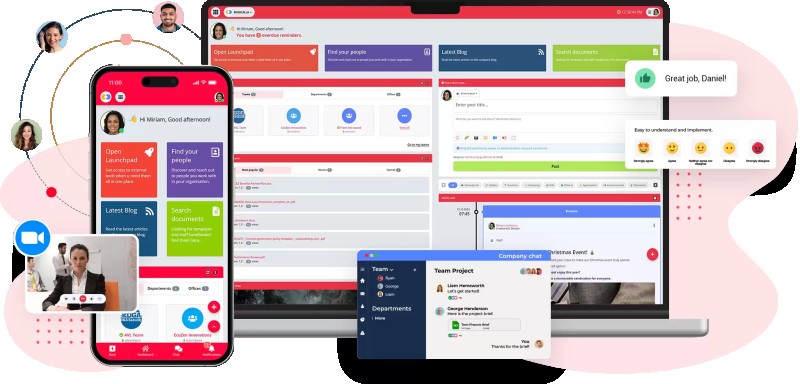Insight Blog
Agility’s perspectives on transforming the employee's experience throughout remote transformation using connected enterprise tools.
15 minutes reading time
(3072 words)
The Future of Work Orders in Manufacturing: How Automation and AI Are Transforming Production
Explore how AI & automation are revolutionizing work orders in manufacturing—predictive maintenance, smart scheduling & IoT integration shaping Industry 4.0
In the rapidly evolving manufacturing landscape, the concept of work orders—a cornerstone of production planning and control—is significantly transforming.
As we delve into "The Future of Work Orders in Manufacturing," it's evident that traditional paper-based systems give way to advanced digital solutions.
Integrating work order maintenance software is at the forefront of this evolution, offering manufacturers enhanced efficiency, accuracy, and real-time data access. These digital platforms streamline the creation, assignment, and tracking of work orders, ensuring that maintenance tasks are executed promptly and effectively.
By leveraging such software, organizations can reduce downtime, optimize resource allocation, and maintain a competitive edge in today's dynamic market.
This shift towards digitalization is not merely a trend but a necessity as manufacturers strive to adapt to technological advancements and the increasing demand for agility in production processes.
Embracing modern work order maintenance software paves the way for more intelligent, more responsive manufacturing operations, aligning with the broader movement towards Industry 4.0 and the digital transformation of the industrial sector.
Read this article: : Top 6 AI-Powered Project Management Tools To Use In 2023
What is Work Order Software?
In the dynamic world of manufacturing, efficiently managing maintenance tasks is crucial to minimizing downtime and maintaining productivity.
This type of software has emerged as a transformative solution, automating creating, assigning, and tracking maintenance tasks to ensure seamless operations.
Work order maintenance software is a digital tool designed to streamline maintenance processes by automating task management.
It replaces traditional manual methods, ensuring that each step in production aligns with the overarching goals of smart manufacturing. By digitizing and centralizing information, this software provides real-time visibility into operations, fostering effective communication and collaboration across teams.
This leads to improved efficiency and reduced errors associated with manual processes.
Implementing work order maintenance software offers several significant benefits:
- Enhanced Efficiency: Automating work order processing reduces the time spent on manual data entry and task assignment, allowing maintenance teams to focus on critical tasks.
- Optimized Resource Utilization: The software aids in better scheduling and resource allocation, ensuring that personnel and materials are available when needed and thus minimizing delays.
- Improved Accountability: Clear documentation and tracking make team members more accountable for their tasks, leading to higher completion rates and adherence to schedules.
- Cost Reduction: By facilitating preventive maintenance and reducing unexpected breakdowns, companies can significantly reduce repair costs and extend the lifespan of equipment.
Adopting work order maintenance software has shown tangible benefits in various industries. For instance, companies utilizing such systems have experienced a 20% reduction in material costs and equipment downtime.
It's also worth mentioning that organizations report improved on-time work completion rates due to streamlined scheduling and work order sign-offs.
Quick Poll
The Transformation of Work Orders Through Automation and AI
The traditional work order system has undergone a radical transformation in modern manufacturing environments, evolving from static paper-based directives into intelligent, self-optimizing workflows powered by automation and artificial intelligence.
At the heart of this revolution lies the ability of AI systems to analyze vast amounts of historical maintenance data alongside real-time equipment inputs, enabling the automatic generation of preventive work orders before potential failures even occur.
These smart systems continuously evaluate multiple operational variables including machine availability, technician qualifications, parts inventory levels, and production deadlines to optimize task scheduling with unprecedented precision.
The integration of IoT technology has further enhanced work order systems by embedding them directly into equipment ecosystems. Networked sensors monitoring vibration patterns, temperature fluctuations, and performance metrics can now instantly generate maintenance tickets when anomalies are detected, automatically dispatch the nearest qualified technician, and even provide augmented reality repair guidance on demand.
This seamless connectivity between physical assets and digital systems creates a closed-loop process where work orders dynamically adjust to changing conditions on the production floor.
Manufacturers implementing these advanced systems report significant operational improvements, including 30-50% reductions in unplanned downtime, 25% faster work order completion times, and 20% extensions in equipment lifespan.
As these technologies continue to mature, the next frontier involves fully autonomous work order systems capable of self-optimization in real-time. These systems will not only predict maintenance needs but also automatically reconfigure production schedules, adjust resource allocations, and implement process improvements without human intervention.
This evolution is transforming maintenance operations from reactive cost centers into strategic functions that actively enhance overall equipment effectiveness and production capacity.
The future of work order management lies in creating intelligent, adaptive systems that continuously learn and improve, ultimately driving manufacturing productivity to new heights while minimizing operational disruptions and maximizing asset utilization across the enterprise.
Top 6 Benefits of Work Order Management Software
Work order software is integral to business management, especially for organizations in the services and manufacturing sectors.
By automating and streamlining processes, this software enhances efficiency and boosts productivity. Here are six key benefits of implementing work order software:
#1. Improved Operational Efficiency & Enhanced Productivity
In today's competitive manufacturing landscape, efficiency isn't just an advantage—it's a necessity. According to a 2023 McKinsey report, advanced work order management systems are revolutionizing production floors by automating up to 90% of manual processes.
By eliminating paper-based systems and human data entry, these digital solutions reduce administrative errors by 42% while accelerating workflow execution by 30-50%.
The true power lies in intelligent automation:
- AI-driven scheduling dynamically allocates tasks based on real-time machine availability and workforce capacity.
- Predictive maintenance algorithms analyze equipment sensor data to forecast failures 3-5 weeks in advance, reducing unplanned downtime by 55%
- Automated work order routing ensures the right technician receives the right job with all necessary documentation, cutting resolution times by 35%
These systems don't just react – they anticipate.
By integrating IoT sensors with work order platforms, manufacturers gain:
- 20-25% higher equipment utilization rates
- 15% reduction in overtime costs through balanced workload distribution
- 60% faster onboarding for new technicians via digital work instructions
The productivity impact is measurable—early adopters report 27% higher output per shift with 18% lower operational costs.
As machine learning continues to evolve, these systems will increasingly self-optimize workflows in real time, creating truly autonomous production environments where work orders generate, assign, and track themselves with minimal human oversight.
#2. Intelligent Data-Driven Operations for Decision-Making
Work order management systems have evolved into powerful business intelligence hubs in the modern manufacturing era. These platforms transform raw operational data into actionable insights through:
- Comprehensive Performance Analytics - Real-time dashboards track equipment efficiency, workforce productivity, and order completion rates across all production lines
- Advanced Bottleneck Detection - Machine learning algorithms identify recurring constraints in workflows, enabling proactive process optimization
- Resource Optimization Modeling - Predictive analytics suggest ideal staffing levels, material requirements, and equipment allocations for upcoming production cycles
- Quality Trend Analysis - Historical defect tracking pinpoints recurring quality issues at specific process stages
- Strategic Forecasting Tools - Pattern recognition helps anticipate seasonal demand fluctuations and capacity needs
The system's analytical capabilities create a continuous improvement loop in which every completed work order feeds new insights into operational planning.
Production managers gain:
- Visual workflow mapping showing exact pain points in processes
- Automated KPI tracking with customizable benchmarks
- Root cause analysis for recurring maintenance issues
- Comparative performance reports across shifts and facilities
By converting operational data into strategic knowledge, these platforms enable manufacturers to shift from reactive problem-solving to predictive optimization.
The result is a living operational strategy that constantly evolves based on empirical production data rather than assumptions - ensuring continuous efficiency, quality, and throughput gains.
#3. IoT and AI Integration in Work Order Systems
Modern work order management platforms serve as the central nervous system for Industry 4.0 operations by creating a fully interconnected production environment through cutting-edge technology integration:
1. IoT-Enabled Real-Time Optimization
- Connected sensors feed live equipment data directly into work order systems
- Automated adjustments to production schedules based on:
- Current machine utilization rates
- Environmental conditions (temperature, humidity)
- Immediate material availability
- Dynamic task reassignment when sensors detect:
- Quality deviations in-process
- Unexpected bottlenecks
- Safety parameter breaches
2. AI-Powered Intelligent Automation
- Machine learning models that continuously improve by analyzing:
- Historical maintenance patterns
- Technician response times
- Equipment performance trends
- Cognitive systems that:
- Auto-prioritize urgent work orders
- Optimize maintenance windows
- Predict tooling requirements
3. Unified Operational Intelligence
The convergence of these technologies creates a self-optimizing production floor where:
- IoT devices provide the sensory input
- AI serves as the decision-making brain
- Work order software acts as the central command center
This integration enables:
- Self-adjusting production schedules that respond to real-time conditions
- Anticipatory maintenance protocols that prevent 90% of potential breakdowns
- Automated quality assurance loops that self-correct processes
- Intelligent resource allocation that maximizes workforce efficiency
The result is a manufacturing operation that becomes progressively smarter - where every connected machine, every completed work order, and every operational decision continuously improves the system's overall intelligence and efficiency.
#4. Adaptive Manufacturing Infrastructure for Evolving Industry Demands
When it comes to modern work, order management systems serve as dynamic platforms designed to evolve alongside manufacturing operations in today's rapidly transforming industrial landscape.
These solutions are architected with inherent adaptability, which allows enterprises to fluidly adjust their production management approach in response to technological advancements and shifting market conditions.
The actual value of these systems lies in their architectural elasticity - they can effortlessly expand from managing a single production line to coordinating complex, multi-factory operations without requiring platform replacements.
This scalability ensures manufacturers can immediately capitalize on emerging opportunities, whether that involves onboarding new equipment technologies, accommodating sudden demand surges, or integrating with next-generation industrial automation systems.
As production environments grow more sophisticated, the software's modular framework permits seamless incorporation of additional functionalities - from advanced quality control modules to AI-powered scheduling engines - while maintaining operational continuity.
This future-proof design philosophy enables manufacturers to progressively enhance their capabilities without the disruptive cycle of periodic system overhauls.
The platform's configuration flexibility allows for:
- Custom workflow designs that mirror unique production processes
- Adjustable permission structures for growing teams
- Modular feature activation based on immediate needs
- Interoperability with new equipment and emerging technologies
This adaptive capacity transforms work order systems from static tools into living platforms that mature alongside the business, ensuring manufacturers maintain operational agility regardless of market volatility or technological disruption.
The result is sustained competitive advantage through continuous, frictionless evolution of production management capabilities.
#5. Coordination Through Digital Workflow Integration
And lets get into collaboration, and how it improves and creates a unified digital workspace that bridges departmental silos like AgilityPortal. These platforms establish a single source of truth where engineering teams, floor supervisors, maintenance personnel, and quality assurance specialists can interact with production data in real-time.
The system's intelligent notification framework automatically routes critical updates to relevant stakeholders while maintaining complete audit trails of all communications.
This interconnected environment eliminates traditional information bottlenecks by providing:
- Role-based dashboards that display contextual data for each team member
- Integrated messaging tools with task-specific discussion threads
- Automated escalation paths for time-sensitive issues
- Visual workflow markers that show real-time job status across departments
The platform's communication architecture extends beyond simple alerts to enable proactive collaboration.
When quality inspectors flag an issue, the system simultaneously:
- Notifies the affected production team
- Creates a corrective work order
- Alert supply chain managers about potential material impacts
- Updates planning teams on schedule adjustments
This level of synchronized communication transforms traditional linear workflows into dynamic, cross-functional processes where information flows as freely as materials on the production floor.
The result is a manufacturing operation where decisions are made with full situational awareness; changes are implemented with team-wide visibility and operational objectives are achieved through collective intelligence rather than departmental handoffs.
#6. Ecological Impact and Sustainability
Modern manufacturers are increasingly making sustainability a priority.
Adding zero-waste parameters to existing work order software helps with efficient resource consumption and wastage minimization.
Zero waste enables manufacturers to reduce energy use and carbon footprint. This reduction in emissions certainly aligns with the goals set globally to minimize climate change and makes companies become fair and responsible leaders in the industry.
Challenges and Considerations
While modern work order management systems offer transformative potential for operational efficiency, organizations must approach adoption strategically.
The integration process demands meticulous planning to ensure seamless compatibility with existing operational frameworks and enterprise systems. A comprehensive needs assessment forms the critical foundation for selecting a solution that aligns with current requirements and future growth trajectories.
The human factor presents the most significant implementation challenge, requiring deliberate change management strategies to overcome natural resistance to new workflows.
Proper investment in tailored training programs becomes essential to achieve full user adoption and system utilization. Simultaneously, organizations must rigorously evaluate the cybersecurity implications of digital work order platforms, particularly regarding protecting sensitive operational data and compliance with evolving privacy regulations.
Data migration complexities often emerge as unexpected hurdles, demanding careful mapping of legacy information to new system architectures. The solution's scalability must be verified to accommodate seasonal fluctuations and long-term business expansion without disruptive platform changes.
Vendor selection criteria should extend beyond features, including implementation support quality, system interoperability capabilities, and ongoing maintenance responsiveness.
Ultimately, successful deployment hinges on viewing the work order system not as a standalone tool but as an integrated component of the organization's broader digital transformation strategy.
This holistic approach ensures the technology delivers measurable improvements in maintenance efficiency, asset utilization, and operational visibility while minimizing implementation risks.
Future Trends and Innovations
As we look toward the future of industrial operations, work order systems are poised to undergo radical transformation through emerging technologies. Artificial intelligence and machine learning will evolve from being supplemental features to becoming the core intelligence of these platforms, enabling truly autonomous maintenance decision-making.
We're moving toward systems capable of:
- Self-optimizing workflows that automatically adjust to production variables
- Cognitive predictive maintenance that learns from equipment behavior patterns
- Adaptive scheduling engines that respond to real-time operational changes
The proliferation of industrial IoT will create hyper-connected factories where:
- Every machine component communicates its status
- Work orders generate automatically based on sensor data
- Quality control happens autonomously through vision systems
Cloud-native architectures will democratize access to sophisticated work order management, enabling:
- Global team collaboration across distributed facilities
- Mobile-first operations with AR-assisted maintenance
- Edge computing integration for real-time analytics
These advancements will fundamentally reshape maintenance operations, creating:
- Frictionless knowledge transfer through digital twins
- Self-documenting processes via blockchain ledgers
- Augmented workforce capabilities through AI assistants
The future work order system won't just support operations - it will actively drive continuous improvement through intelligent automation and data-driven optimization, ushering in a new era of manufacturing efficiency and agility.
AgilityPortal as a Work Order Management Solution
AgilityPortal can indeed be adapted for work order management, particularly for organizations seeking a unified platform that combines internal communication with operational workflows.
While not exclusively designed as a Computerized Maintenance Management System (CMMS), its core functionality supports essential work order processes through:
Key Capabilities for Work Order Management
- Custom Request Forms
- Create tailored work order submission forms with required fields (asset details, priority levels, issue descriptions)
- Attach supporting documents/images directly to requests
- Automated Routing & Notifications
- Configure approval workflows to route requests to appropriate teams
- Real-time alerts for new assignments, status updates, and deadline reminders
- Task Tracking & Accountability
- Assign tasks with clear deadlines and dependencies
- Audit trails showing complete request history and resolution timelines
- Mobile Accessibility
- Technicians can update work orders on-site via mobile devices
- Push notifications for urgent assignments
- Integration Potential
- Connect with existing asset management tools via API
- Embed dashboards showing work order analytics
Best Suited For
✔ Small-to-midsize operations needing basic work order functionality
✔ Companies already using AgilityPortal for internal communications
✔ Organizations wanting to combine work orders with team collaboration
Wrapping up
Work order software will remain critical as smart manufacturing continues to evolve.
This software provides a solid platform that integrates operations, enhances collaboration, and facilitates data-driven decisions, making it a key component of modern manufacturing strategies. It is expected to usher in a new era of excellence in manufacturing.
Adopting these technologies helps manufacturers stay ahead, optimize processes, and contribute to a more sustainable and profitable future. With diligent deployment and ongoing evolution, the sky is the limit when it comes to growth and success in the manufacturing industry.
Frequently Asked Questions (FAQs) About Work Order Software
1. Is there free work order management software available?
Yes, there are several free work order management software options, such as MaintainX (free tier), UpKeep (free plan), and open-source solutions like Odoo. These platforms offer basic task tracking, scheduling, and reporting features, making them ideal for small teams or businesses on a budget.
2. What is the best work order software for small businesses?
The best work order software for small business includes UpKeep, Fiix, and Hippo CMMS, which offer affordable pricing, easy setup, and essential features like mobile access, automated work orders, and basic reporting.
3. Can work order software be used for maintenance tasks?
Yes, work order software for maintenance helps streamline repair requests, preventive maintenance scheduling, and asset tracking. Solutions like Limble CMMS and eMaint are designed specifically for maintenance teams.
4. What are the best work order software examples for enterprises?
Some of the best work order software examples for larger organizations include IBM Maximo, ServiceNow, and Oracle SCM, which offer advanced features like IoT integration, AI-driven analytics, and multi-site management.
5. Are there free facility maintenance work order software options?
Yes, facility maintenance work order software with free plans includes FMX and Maintenance Care, which help manage building repairs, equipment checks, and service requests without upfront costs.
6. What are some simple work order software examples for quick setup?
For businesses needing simple work order software examples, platforms like Zoho Creator, QuickBase, and Housecall Pro provide user-friendly interfaces, customizable forms, and mobile accessibility for easy adoption.
Categories
Blog
(2600)
Business Management
(319)
Employee Engagement
(207)
Digital Transformation
(173)
Intranets
(119)
Growth
(118)
Remote Work
(61)
Sales
(48)
Collaboration
(37)
Culture
(29)
Project management
(29)
Customer Experience
(26)
Knowledge Management
(21)
Leadership
(20)
Comparisons
(5)
Ready to learn more? 👍
One platform to optimize, manage and track all of your teams. Your new digital workplace is a click away. 🚀
Free for 14 days, no credit card required.















